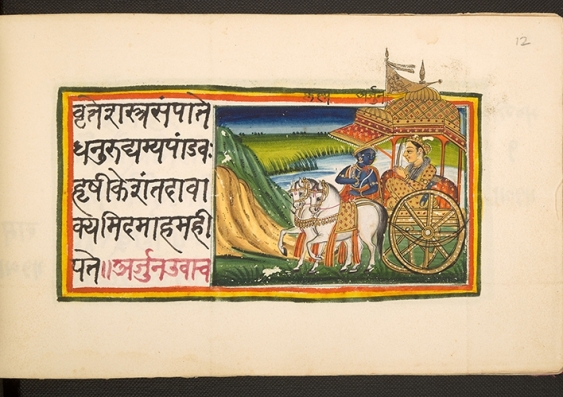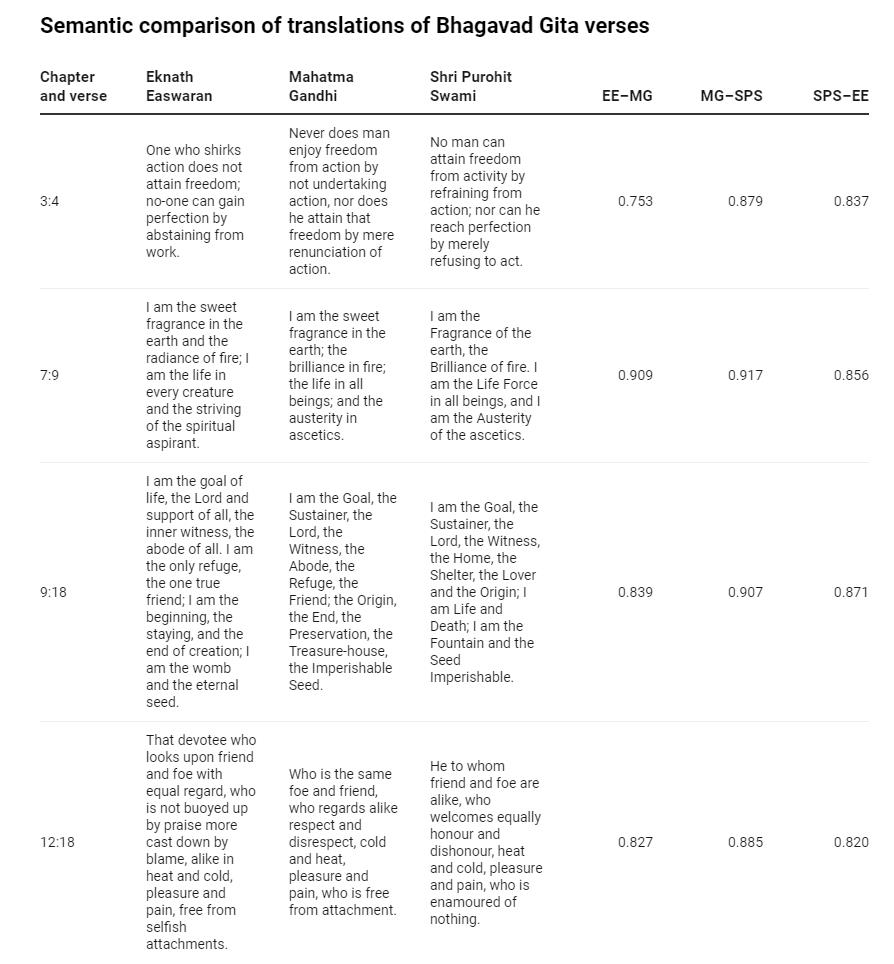创新背景
机器学习和其他人工智能(AI)方法在预测蛋白质分子如何折叠和识别人群中的面孔等科学和技术任务方面取得了巨大成功。然而,这些方法在人文学科中的应用还有待充分探索。
例如,关于哲学和宗教,人工智能能告诉我们什么?作为这种探索的起点,研究人员使用深度学习的人工智能方法来分析《薄伽梵歌》的英文译本,这是一本最初用梵文写成的古印度教文本。
《薄伽梵歌》的第一部英译本出版于1785年。《薄伽梵歌》的英译本数不胜数,但没有多少作品能证实其质量。歌曲和诗歌的翻译不仅会破坏韵律和押韵模式,还会导致语义信息的丢失。
创新过程
在这项研究中,研究人员使用深度学习语言模型分析了《薄伽梵歌》(从梵文到英语)的三个选定译文,并进行语义和情感分析,以帮助评估翻译质量。他们使用谷歌开发的预训练语言模型BERT,并使用基于Twitter帖子的人类标记训练数据集进一步调整了模型,该数据集捕捉了10种不同的情绪。

这些情绪(乐观、感恩、同理心、悲观、焦虑、悲伤、烦恼、否认、惊讶和开玩笑)来自之前对COVID-19大流行期间社交媒体情绪的研究。科学家们研究的三种译本使用了非常不同的词汇和语法,但语言模型在各自译本的不同章节中识别出了相似的情绪。根据模型,乐观、烦恼和惊讶的情绪表达得最多。
新开发的语言模型为《薄伽梵歌》的不同翻译捕捉到了情感。此外,该模型还展示了在阿诸那和克利须那主的对话过程中,整体情绪极性的变化(从消极到积极)。
下表显示了三个译本中一些语义上最相似的经文。

阿诸那在一开始是悲观的,在克里沙勋爵传授他印度教哲学知识后变得乐观起来。克里希纳所表达的情感表明,有了佛法的哲学知识和导师的指导,陷入困境的心灵可以在冲突时清晰地做出正确的决定。
新模型的一个局限性是,它是根据来自Twitter的数据进行训练的,因此它将“开玩笑”视为一种常见情绪。它把这个标签不恰当地用在薄伽梵歌的某些部分上。
创新关键点
研究人员使用深度学习语言模型分析了《薄伽梵歌》(从梵文到英语)的三个选定译文,并进行语义和情感分析,以帮助评估翻译质量。他们使用谷歌开发的预训练语言模型BERT,并使用基于Twitter帖子的人类标记训练数据集进一步调整了模型,该数据集捕捉了10种不同的情绪。
创新价值
这项研究为使用基于人工智能的技术来比较翻译和审查广泛文本中的情绪开辟了一条道路。
这项技术还可以扩展到评论娱乐媒体表达的情绪。另一个潜在的应用是分析电影和歌曲,为父母和权威机构提供关于内容是否适合儿童的见解。
Innovative uses machine learning to analyze ancient Hindu sacred texts from multiple perspectives
In the study, the researchers analyzed three selected translations of the Bhagavad Gita, from Sanskrit to English, using deep learning language models and performed semantic and sentiment analyses to help assess translation quality. They used BERT, a pre-trained language model developed by Google, and further tuned the model using a training dataset of human markers based on Twitter posts, which captured 10 different emotions.
The emotions (optimism, gratitude, empathy, pessimism, anxiety, sadness, annoyance, denial, surprise, and joking) come from previous research on social media sentiment during the COVID-19 pandemic. The three translations the scientists studied used very different vocabulary and grammar, but the language models identified similar emotions in different chapters of each translation. According to the model, optimism, annoyance and surprise were expressed the most.
The newly developed language model captures emotions for different translations of the Bhagavad Gita. In addition, the model shows the change of overall emotional polarity (from negative to positive) during the course of the dialogue between Arjuna and Lord Krishna.
Arjuna, who was pessimistic at first, became optimistic after Lord Krisha taught him about Hindu philosophy. The sentiments expressed by Krishna show that with the philosophical knowledge of the Dhamma and the guidance of the guru, the troubled mind can clearly make the right decision in times of conflict.
One limitation of the new model is that it is trained on data from Twitter, so it treats "joking" as a common emotion. It applies the label inappropriately to certain parts of the Bhagavad Gita.
智能推荐
AI+新闻学 | 利用机器学习预测新闻报道的真实性
2022-08-09研究团队开发了一种新的系统,利用机器学习检测网站的可信度和信息来源的语言特征,只需约150篇文章即可检测新闻的准确性和倾向性。这种新的检测方法可以使假新闻在广泛传播之前被及时发现,并删除。
涉及学科涉及领域研究方向表演理论创新 | 融合多学科创新戏剧表演方式
2022-08-03融汇历史、艺术、文学,结合多学科知识重建17世纪的莫里哀戏剧舞台。
涉及学科涉及领域研究方向通过大脑成像技术研究45种语言的使用者触发不同任务时的大脑反应
2022-07-19通过大脑成像技术研究45种语言的使用者触发不同任务时的大脑反应,发现不同语言使用者类似的大脑激活和语言选择性模式,揭示语言网络整体架构和属性的通用性。
涉及学科涉及领域研究方向